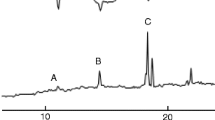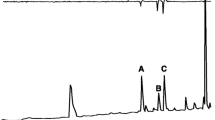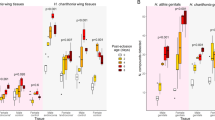Abstract
We present the identification of the sex pheromone in the pine sawfly, Gilpinia pallida, including analysis of the female pheromone content, male antennal response and attraction in the field, and synthesis of the most active pheromone component. Several 3,7-dimethyl-2-alkanols were identified from female whole-body extracts, including some compounds with a 2R configuration. This is the first observation of such compounds in a pine sawfly species. Antennae of male G. pallida responded strongly in electroantennograph (EAG) recordings to the (2S,3R,7R)-isomers of the propionates of 3,7-dimethyl-2-tridecanol, 3,7-dimethyl-2-tetradecanol, and 3,7-dimethyl-2-pentadecanol, as well as to the acetates of the tri- and pentadecanols (the acetate of the tetradecanol was not tested). The propionate of (2S,3R,7R)-3,7-dimethyl-2-tetradecanol caught more males in the field than the corresponding isomer of tri- or pentadecanol. We suggest that the (2S,3R,7R)-isomer of 3,7-dimethyl-2-tetradecanol is likely the main sex pheromone precursor in G. pallida, with a subsidiary role for the (2S,3R,7R)-isomer of the tridecanol. Preparation of highly pure (2R,3R,7R)- and (2S,3R,7R)-stereoisomers of 3,7-dimethyl-2-tetradecanol, including the biological active esters, was performed via chemoenzymatic methods and is described in detail.




Similar content being viewed by others
References
Anderbrant, O. 1993. Pheromone biology of sawflies, pp. 119–154, in M. R. Wagner and K. F. Raffa (eds.). Sawfly Life History Adaptations to Woody Plants. Academic Press, New York.
Anderbrant, O. 1999. Sawflies and seed wasps, pp. 199–226, in J. Hardie and A. K. Minks (eds.). Pheromones of Non-Lepidopteran Insects Associated with Agricultural Plants. CAB International, Wallingford, UK.
Anderbrant, O., Löfqvist, J., Jönsson, J., and Marling, E. 1989. Effects of pheromone trap type, position and colour on the catch of the pine sawfly Neodiprion sertifer (Geoff.) (Hym., Diprionidae). J. Appl. Entomol. 107:365–369.
Anderbrant, O., Löfqvist, J., Bengtsson, M. and Baeckström, P. 1992. Field response of the pine sawfly Neodiprion sertifer to controlled release of diprionyl acetate, diprionyl propionate and trans-perillenal. J. Chem. Ecol. 18:1707–1725.
Anderbrant, O., Östrand, F., Bergström, G., Wassgren, A.-B., Auger-Rozenberg, M.-A., Geri, C., Hedenström, E., Högberg, H.-E., Herz, A., and Heitland, W. 2005. Release of sex pheromone and its precursors in the pine sawfly Diprion pini. Chemoecology 15:147–151.
Bergström, G., Wassgren, A.-B., Anderbrant, O. Hedenström, E., Högberg, H.-E., Fägerhag, J., Edlund, H., Geri, C. Auger, M. A., Varama, M., Hansson, B. S., and Löfqvist, J. 1995. Sex pheromone of the pine sawfly Diprion pini (Hymenoptera: Diprionidae): Chemical identification, synthesis and biological activity. Experientia 51:370–380.
Bergström, G., Wassgren, A.-B., Anderbrant, O., Ochieng, S. A., Östrand, F., Hansson, B. S., Hedenström, E., and Högberg, H.-E. 1998. The sex pheromone of the pine sawfly Microdiprion pallipes (Hymenoptera: Diprionidae). Naturwissenschaften 85:244–248.
Hedenström, E. and Andersson, F. 2002. Synthesis of female sex pheromone precursors of pine sawfly species and of some structurally related methyl-branched long-chain 2-alkanols. J. Chem. Ecol. 28:1237–1254.
Hedenström, E., Högberg, H.-E., Wassgren, A.-B., Bergström, G., Löfqvist, J., Hansson, B., and Anderbrant, O. 1992. Sex pheromone of pine sawflies. Chiral synthesis of some active minor components isolated from Neodiprion sertifer and some chiral analogues of diprionyl acetate. Tetrahedron 48:3139–3146.
Hedenström, E., Edlund, H., Lund, S., Abersten, M., and Persson, D. 2002. Synthesis and lipase catalysed stereoselective acylation of some 3-methylalkan-2-ols, identified as sex pheromone precursors in females of pine sawfly species. J. Chem. Soc., Perkin Trans. 1 2002:1810–1817.
Hedenström, E., Nguyen, B.-V., and Silks, L. A. III. 2002. Do enzymes recognise remotely located stereocentres? Highly enantioselective Candida rugosa lipase-catalysed esterification of the 2- to 8-methyldecanoic acids. Tetrahedron: Asymmetry 13:835–844.
Hedenström, E., Edlund, H., and Lund, S. 2003. Stereoselective esterification of 2,6-dimethyl-1,7-heptanedioic acid, catalysed by Candida rugosa lipase. J. Mol. Catal., B Enzym. 23:53–59.
Herz, A. and Heitland, W. 2002. Comparison of the fat allocation patterns in female pine sawflies (Hymenoptera: Diprionidae). Eur. J. Entomol. 99:117–120.
Herz, A., Heitland, W., Anderbrant, O., Edlund, H., and Hedenström, E. 2000. First use of pheromones to detect phenology patterns and density relationships of pine sawflies in German forests. Agric. For. Entomol. 2:123–129.
Högberg, H. -E., Hedenström, E., Wassgren, A. -B., Hjalmarsson, M., Bergström, G., Löfqvist, J., and Norin, T. 1990. Synthesis and gas chromatographic separation of the eight stereoisomers of diprionol and their acetates, components of the sex pheromone of pine sawflies. Tetrahedron 46:3007–3018.
Högberg, H.-E., Hedenström, E., Fägerhag, J., and Servi, S. 1992. Enantioselective synthesis of (S)-2-methyl-1-alkanols via bakers’ yeast mediated reduction of α-methyl-2-thiophenepropenals. J. Org. Chem. 57:2052–2059.
Jewett, D. M., Matsumura, F., and Coppel, H. C. 1976. Sex pheromone specificity in the pine sawflies: Interchange of acid moieties in an ester. Science 192:51–53.
Karlsson, S. and Hedenström, E. 1999. Sex pheromone of the pine sawfly, Macrodiprion nemoralis. Stereoselective synthesis of the sixteen stereoisomers of 3,7,9-trimethyl-2-tridecyl acetate. Acta Chem. Scand. 53:620–630.
Kikukawa, T., Matsumura, F., Kraemer, M., Coppel, H. C., and Tai, A. 1982. Field attractiveness of chirally defined synthetic attractants to males of Diprion similis and Gilpinia frutetorum. J. Chem. Ecol. 8:301–314.
König, W. A., Francke, W., and Benecke, I. 1982. Gas chromatographic enantiomer separation of chiral alcohols. J. Chromatogr. 239:227–231.
Larsson, M., Nguyen, B.-V., Hedenström, E., and Högberg, H.-E. 2001. Syntheses of the sixteen stereoisomers of 3,7,11-trimethyl-2-tridecanol, including the (2S,3S,7S,11R)- and (2S,3S,7S,11S)-stereoisomers identified as pheromone precursors in females of the pine sawfly Microdiprion pallipes (Hymenoptera: Diprionidae). Eur. J. Org. Chem. 2001:353–363.
Levene, P. A. and Marker, R. E. 1932. Maximum rotations and correlation of disubstituted acetic acids containing a methyl group. J. Biol. Chem. 98:1–7.
Nikishin, G. I., Ogibini, Y. N., and Rakhmatullina, L. K. 1974. Peroxydisulfate-initiated reactions of 1-heptene with acetic and propionic acids. Bull. Acad. Sci. USSR Div. Chem. Sci. (Engl. Transl.) 23:1479–1483.
Östrand, F., Wassgren, A.-B., Anderbrant, O., Bergström, G., Hedenström, E., Högberg, H.-E., Nguyen, B.-V., and Larsson, M. 2003. Stereoisomeric composition of the sex pheromone of the pine sawfly Microdiprion pallipes (Hym., Diprionidae). Chemoecology 13:155–162.
Pschorn-Walcher, H. 1982. Unterordnung Symphyta, Pflanzenwespen, pp. 4–234, in W. Schwenke (ed.). Die Forstschädlinge Europas, Bd 4. Paul-Parey Verlag, Hamburg.
Smith, D. R. 1993. Systematics, life history, and distribution of sawflies, pp. 3–32, in M. R. Wagner and K. F. Raffa (eds.). Sawfly Life History Adaptations to Woody Plants. Academic Press, New York.
Wassgren, A.-B. and Bergström, G. 1995. Quantitative high-resolution gas chromatographic determination of stereoisomeric composition of chiral volatile compounds in the picogram range by EC-detection. J. Chem. Ecol. 21:987–994.
Wassgren, A.-B., Anderbrant, O., Löfqvist, J., Hansson, B. S., Bergström, G., Hedenström, E., and Högberg, H.-E. 1992. Pheromone related compounds in pupal and adult female pine sawflies, Neodiprion sertifer, of different age and in different parts of the body. J. Insect Physiol. 38:885–893.
Wassgren, A.-B., Bergström, G., Sierpinski, A., Anderbrant, O., Högberg, H.-E., and Hedenström, E. 2000. Sex pheromone of the pine sawfly Macrodiprion nemoralis (Hymenoptera: Diprionidae): Identification of the precursor (2S,3R,7R,9S)-3,7,9-trimethyl-2-tridecanol and the active pheromone (2S,3R,7R,9S)-3,7,9-trimethyl-2-tridecyl acetate. Naturwissenschaften 87:24–29.
Acknowledgments
We thank Johan Kristoffersson for help with the field test in Arjeplog, Sweden. The research was supported by the Swedish Natural Science Research Council (NFR), Swedish Council for Forestry and Agricultural Research (SJFR), Carl Trygger’s Foundation for Scientific Research and the Commission of the European Communities, Agriculture and Fisheries (FAIR), specific RTD program, contract no. FAIR1-CT95-0339, “Pine sawfly pheromones for sustainable management of European forests” (PHERODIP). This study does not necessarily reflect the Commission’s view and in no way anticipates its future policies in this area. Financial support to the group in Göteborg from The Royal Society of Arts and Sciences in Göteborg (KVVS) and the Ebba and Sven Schwartz Foundation is gratefully acknowledged.
Author information
Authors and Affiliations
Corresponding author
Rights and permissions
About this article
Cite this article
Hedenström, E., Edlund, H., Wassgren, AB. et al. Sex Pheromone of the Pine Sawfly, Gilpinia pallida: Chemical Identification, Synthesis, and Biological Activity. J Chem Ecol 32, 2525–2541 (2006). https://doi.org/10.1007/s10886-006-9161-5
Published:
Issue Date:
DOI: https://doi.org/10.1007/s10886-006-9161-5




